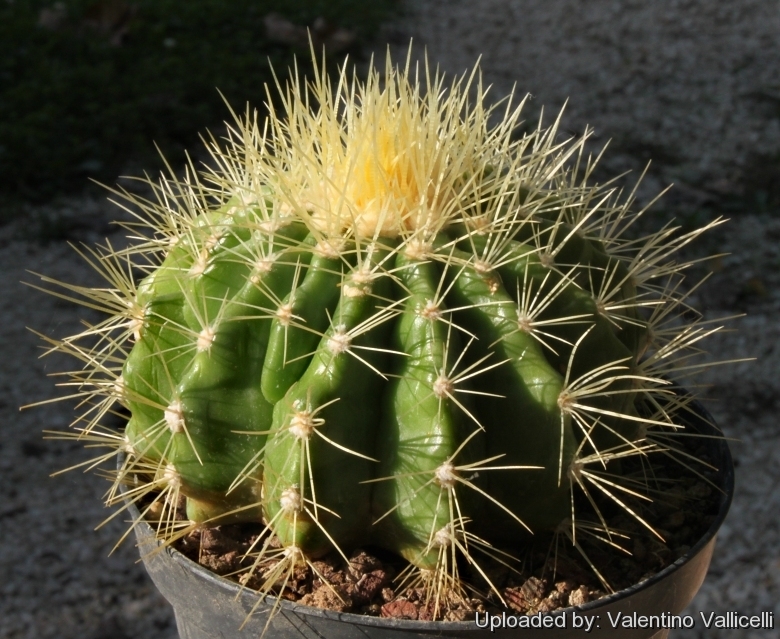
Echinocactus grusonii f. setispinus Photo by: Valentino Vallicelli
This cultivate form has very thin acicular spines, that become longer as the plant ages. Older specimens are really spectacular.
Origin and Habitat: Garden origin (Nursery produced cultivar)
Synonyms:
See all synonyms of Echinocactus grusonii
Description: This plant differs from the common Golden barrel cactus (Echinocactus grusoniiSN|3345]]SN|3345]]) only for the fine spination. Spines are yellowish-white, very thin acicular, that become longer as the plant ages, 2 to 7 cm long. Except for the spines it is identical in shape and size to the standard species. It has a single slowly growing globe-shaped stem that became elongated (barrel-shaped) in maturity, up to 90cm in height and spread. This stem is pale green and heavily ribbed with numerous areoles sprouting radial, yellow spines. They normally offset with advanced age and a few multiples occur even at small sizes.
Flowers: The flowers are produced from end of spring to summer only on larger mature specimens receiving enough full sun. Flower are diurnal, vivid yellow (4-5 cm wide) and form a circular ring at the top of the plant, but are not very visible being small in relation with the size of the barrel, and lost into the creamy coloured wool at the plant apex.
Subspecies, varieties, forms and cultivars of plants belonging to the Echinocactus grusonii group
 Echinocactus grusonii Hildm.: It produces slowly growing barrel-shaped stem up to 90 cm (180 cm) in height and spread. The stem is pale green and heavily ribbed with very numerous areoles and golden yellow spines.
Echinocactus grusonii Hildm.: It produces slowly growing barrel-shaped stem up to 90 cm (180 cm) in height and spread. The stem is pale green and heavily ribbed with very numerous areoles and golden yellow spines. Echinocactus grusonii var. albispinus Y.Itô: It looks just like a regular "Golden Barrel" but the spines are glassy-white instead of yellow.
Echinocactus grusonii var. albispinus Y.Itô: It looks just like a regular "Golden Barrel" but the spines are glassy-white instead of yellow. Echinocactus grusonii var. albispinus f. cristatus hort.: crested form with spines all white instead of yellow.
Echinocactus grusonii var. albispinus f. cristatus hort.: crested form with spines all white instead of yellow. Echinocactus grusonii f. cristatus hort.: This is a wavy crested form with golden-yellow spines. It can also get very big making a spectacular specimen.
Echinocactus grusonii f. cristatus hort.: This is a wavy crested form with golden-yellow spines. It can also get very big making a spectacular specimen. Echinocactus grusonii var. intermedius hort.: This plant differs from the common Golden Barrel Cactus for the spines that are stout but intermediate in length between the standard from and the short spined type "subinermis" (syn: brevispinus).
Echinocactus grusonii var. intermedius hort.: This plant differs from the common Golden Barrel Cactus for the spines that are stout but intermediate in length between the standard from and the short spined type "subinermis" (syn: brevispinus).- Echinocactus grusonii var. intermedius f. cristatus hort.: Strong crested form with stout spines that are intermediate in length between the standard from and the short spined type "subinermis" (syn. brevispinus).
 Echinocactus grusonii var. intermedius f. variegatus hort.: Yellow and green, variegated plants with short, spines that are intermediate in length between the standard from and the short spined type "subinermis" (syn. brevispinus).
Echinocactus grusonii var. intermedius f. variegatus hort.: Yellow and green, variegated plants with short, spines that are intermediate in length between the standard from and the short spined type "subinermis" (syn. brevispinus). Echinocactus grusonii var. intertextus Y.Itô: (a.k.a "Krauskopf" or "tortulispinus") This plant differs from the common Golden barrel cactus for the spines, that are yellowish-white, sparse, flattish, curved to almost crinkled backward and very irregular, 2 to 6 cm long.
Echinocactus grusonii var. intertextus Y.Itô: (a.k.a "Krauskopf" or "tortulispinus") This plant differs from the common Golden barrel cactus for the spines, that are yellowish-white, sparse, flattish, curved to almost crinkled backward and very irregular, 2 to 6 cm long. Echinocactus grusonii var. intertextus f. cristatus hort.: Crested form with characteristich curved spines, that are flattish, almost crinkled backward and very irregular.
Echinocactus grusonii var. intertextus f. cristatus hort.: Crested form with characteristich curved spines, that are flattish, almost crinkled backward and very irregular. Echinocactus grusonii f. monstruosus cristatus hort.: Crested form of the mostrose cultivar covered by white wool with short yellow spines. The crests are quite unstable
Echinocactus grusonii f. monstruosus cristatus hort.: Crested form of the mostrose cultivar covered by white wool with short yellow spines. The crests are quite unstable Echinocactus grusonii f. monstruosus hort.: Free offsetting small form covered by yellowhish-white wool with short yellow spines. The rib structure is not yet apparent, and they have pronounced tubercles making them look superficially like Mammillarias.
Echinocactus grusonii f. monstruosus hort.: Free offsetting small form covered by yellowhish-white wool with short yellow spines. The rib structure is not yet apparent, and they have pronounced tubercles making them look superficially like Mammillarias. Echinocactus grusonii var. setispinus f. minor cristatus hort.: This is the tiniest crested form. A dwarf form covered by touch friendly spines and looking quite dissimilar to the standard species.
Echinocactus grusonii var. setispinus f. minor cristatus hort.: This is the tiniest crested form. A dwarf form covered by touch friendly spines and looking quite dissimilar to the standard species. Echinocactus grusonii var. setispinus f. minor mostruosus cristatus cv. Scarascia: The plant forms lots of tiny monstrous wooly heads, that time by time begin to crest.
Echinocactus grusonii var. setispinus f. minor mostruosus cristatus cv. Scarascia: The plant forms lots of tiny monstrous wooly heads, that time by time begin to crest. Echinocactus grusonii f. setispinus hort.: This cultivar has very thin acicular spines, that become longer as the plant ages.
Echinocactus grusonii f. setispinus hort.: This cultivar has very thin acicular spines, that become longer as the plant ages. Echinocactus grusonii var. subinermis Y.Itô: (a.k.a. "cv. TOGENASHI KINSHACHI", "inermis" or "brevispinus") This is very short spined mutantant. Except for the spines it is identical in shape and size to the standard species.
Echinocactus grusonii var. subinermis Y.Itô: (a.k.a. "cv. TOGENASHI KINSHACHI", "inermis" or "brevispinus") This is very short spined mutantant. Except for the spines it is identical in shape and size to the standard species. Echinocactus grusonii var. subinermis f. cristata hort.: This is the crested form of the short-spined Golden Barrel. This crest can also get very large
Echinocactus grusonii var. subinermis f. cristata hort.: This is the crested form of the short-spined Golden Barrel. This crest can also get very large
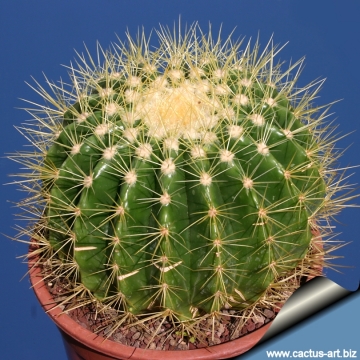 Echinocactus grusonii f. setispinus Photo by: Cactus Art
Echinocactus grusonii f. setispinus Photo by: Cactus Art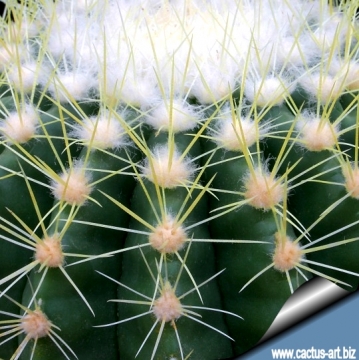 Echinocactus grusonii f. setispinus Photo by: Cactus Art
Echinocactus grusonii f. setispinus Photo by: Cactus Art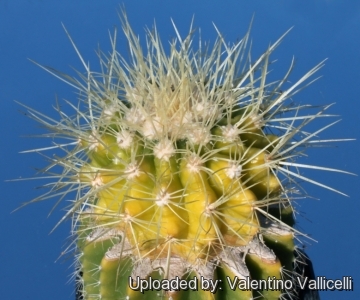 Echinocactus grusonii f. setispinus Photo by: Valentino Vallicelli
Echinocactus grusonii f. setispinus Photo by: Valentino Vallicelli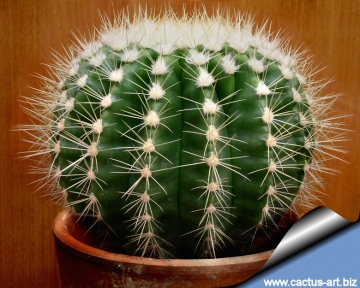 This plant differs from the common Golden barrel cactus for the very fine yellowish-white spination. Photo by: Cactus Art
This plant differs from the common Golden barrel cactus for the very fine yellowish-white spination. Photo by: Cactus Art Echinocactus grusonii f. setispinus Photo by: Cactus Art
Echinocactus grusonii f. setispinus Photo by: Cactus Art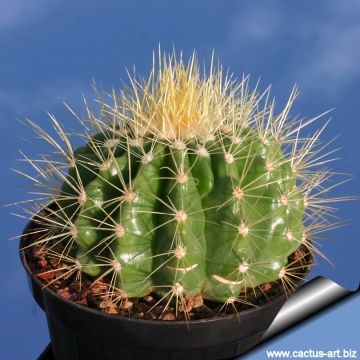 Echinocactus grusonii f. setispinus Photo by: Cactus Art
Echinocactus grusonii f. setispinus Photo by: Cactus ArtCultivation and Propagation: Echinocactus grusoniiSN|3345]]SN|3345]] are summer-growing and pretty easy plants to cultivate. They are suited for any rich, well drained soil such us clay, pumice, lava grit, and only a little peat or leaf-mould. If potted, repot preferably in the spring, if their roots become cramped. Generally, they should be repotted every other year in order to provide fresh soil. However, this doesn't necessarily mean they'll need larger containers. Fill about a quarter of the pot with broken crocks, gravel, etc. to promote good drainage. After repotting, do not water for a week or more. Water regularly during the aestival growth cycle (this plant need plenty of water, but do not overwater and let their soil dry out between waterings), and also needs to be avoided wetting the body of this plant while it is in sunlight. A wet cactus in the sun light can cause sun burning which can lead to scars or even fungal infections and death, keep rather dry in winter. No water should ever be allowed to stand around the roots. Feed with a high potassium fertilizer in summer.
Exposure: Outside they need a bright exposure, full sun or half shade in summer if the location is exceedingly hot or bright, inside needs bright light, and some direct sun. It can tolerate moderate shade, and a plant that has been growing in shade should be slowly hardened off before placing it in full sun as the plant will be severely scorched if moved too suddenly from shade into sun.
Frost Tolerance: Light frost protection required for safe cultivation, but can tolerate sporadic light frost.
Diseases and pests: Watch for infestations of mealybug, scale insects and spider mite. Plant in good conditions will start to bloom when reach the diameter of 40-50 cm.
















